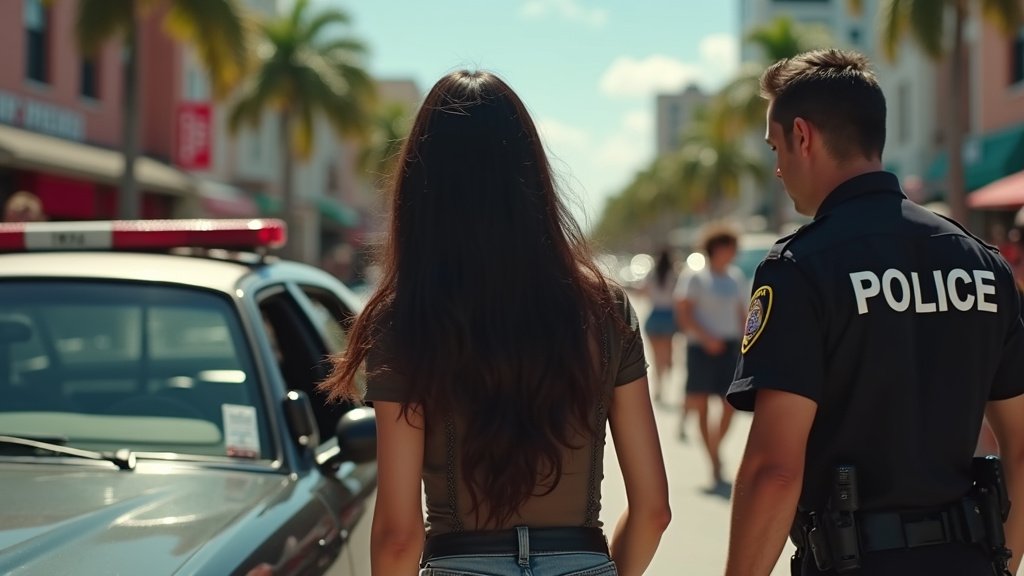A video purporting to show social media personality Natalie Reynolds being arrested by police in Miami has recently taken the internet by storm, sparking widespread debate and disbelief across platforms like TikTok and Instagram. The viral footage depicts Reynolds being handcuffed and placed into a police vehicle, with captions suggesting her apprehension was due to public indecency while allegedly filming content for her OnlyFans account in her car. However, an in-depth investigation into the incident reveals significant inconsistencies, pointing strongly to the video being a meticulously staged event designed for maximum online engagement.
The Miami ‘Arrest’ That Rocked Social Media
The footage, initially circulated by accounts like The Hollywood Fix, quickly amassed millions of views, fueling a frenzy of speculation about the popular OnlyFans creator. Viewers witnessed a scene seemingly unfolding in Miami, with a police officer conducting a pat-down and then escorting Reynolds into a patrol car. The dramatic nature of the clip, coupled with its unverified context, immediately captured the attention of social media users, many of whom questioned its authenticity from the outset.
Unraveling the Inconsistencies
Close scrutiny of the viral video reveals several critical discrepancies that undermine its credibility as a genuine arrest. One of the most glaring issues is the police officer’s uniform, which conspicuously lacks any specific department or agency identification, displaying only the generic word “Police.” This absence of official markings is highly unusual for legitimate law enforcement personnel. Furthermore, the patrol car seen in the video does not match the standard vehicles utilized by the Miami Police Department, raising immediate red flags for observant viewers.
Beyond the visual cues, the alleged pat-down procedure performed by the officer has been widely criticized as unprofessional and awkward, inconsistent with standard police protocol. Rather than using the back of his hand, the officer is seen using a full hand to check Reynolds, an action many netizens swiftly highlighted as uncharacteristic of a real arrest. Compounding these visual anomalies, official checks of Miami databases have yielded no arrest records for Natalie Reynolds pertaining to this incident, further solidifying the premise that the event was fabricated.
A History of Viral Stunts and Pranks
The likelihood of the Miami arrest being a staged performance is significantly amplified by Natalie Reynolds’ well-documented history of orchestrating elaborate pranks and viral stunts to generate content. The influencer, who commands a substantial online following with nearly a million TikTok followers and a significant presence on OnlyFans, YouTube, and Kick, is renowned for pushing boundaries and creating controversial scenarios for digital notoriety. This is far from her first foray into manufactured drama.
Previously, Reynolds gained viral attention for falsely claiming to be the daughter of Hollywood actor Ryan Reynolds, a rumor she herself propagated for clicks. This baseless claim was quickly debunked, highlighting her willingness to blur the lines between reality and fiction for content. Another notable incident involved her public display of distress outside TikTok headquarters in Los Angeles, following a ban from the platform. While she attributed the ban to rival creators, many online commentators linked it to a highly criticized prank where she allegedly offered a homeless woman $20 to jump into Lady Bird Lake in Austin, Texas, despite knowing the woman couldn’t swim, then reportedly abandoning her.
Her portfolio of stunts also includes a “kidnapping prank” which she later spun into a false narrative of a real police encounter, claiming extensive law enforcement response that never occurred. These past actions establish a clear pattern of behavior: Natalie Reynolds thrives on manufactured controversy and shocking viral moments, reinforcing the skepticism surrounding her latest “arrest” video.
The Business of Manufactured Virality and Trendmakers
This incident shines a spotlight on a broader phenomenon within the influencer economy where content creators, acting as modern-day Trendmakers, increasingly resort to extreme or fabricated scenarios to maintain relevance and boost engagement. In a highly saturated digital landscape, the pressure to go viral can lead some to prioritize shock value and sensationalism over authenticity. The promise of millions of views, increased follower counts, and potential monetization drives a continuous cycle of escalating stunts.
These manufactured events often leverage the public’s inherent curiosity and desire for dramatic content. For influencers like Reynolds, the line between personal life and public performance is often deliberately blurred, turning everyday interactions, or even fabricated legal troubles, into prime content. This strategy, while controversial, undeniably generates significant buzz and engagement, proving effective in the short term for audience capture and algorithm manipulation.
Public Reaction and the Quest for Authenticity
The public’s reaction to the alleged Miami arrest video was swift and divided. While many were initially caught off guard, a significant portion of netizens quickly employed their own fact-checking skills, identifying the inconsistencies and calling out the video as a probable hoax. This collective skepticism underscores a growing awareness among social media users regarding the often-unreliable nature of viral content and the deliberate strategies employed by some influencers. The incident serves as a stark reminder of the challenges in discerning truth from fiction in an era where digital content is easily manipulated and sensationalism often triumphs over veracity.
Conclusion
Given the overwhelming evidence of inconsistencies, coupled with Natalie Reynolds’ extensive history of staging elaborate stunts for social media, the viral video depicting her arrest in Miami is overwhelmingly likely to be another calculated performance. There are no credible reports or official records confirming an arrest, and the visual cues within the video itself contradict standard police procedures. This latest episode underscores the ongoing battle for authenticity in the influencer sphere, where the pursuit of viral fame often leads to content creators blurring ethical lines, leaving audiences to navigate a complex landscape of entertainment, reality, and deliberate deception.





